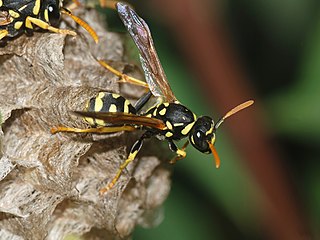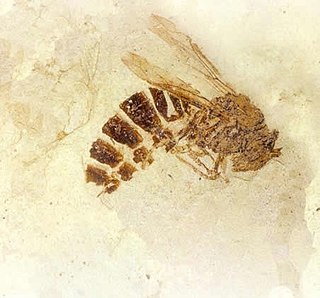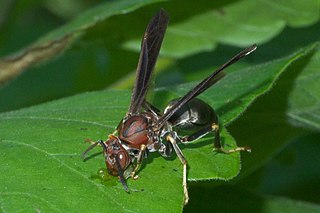
Paper wasps are vespid wasps that gather fibers from dead wood and plant stems, which they mix with saliva, and use to construct nests made of gray or brown papery material. Some types of paper wasps are also sometimes called umbrella wasps, due to the distinctive design of their nests.

Wasps of the cosmopolitan genus Polistes are the most familiar of the polistine wasps, and are the most common type of paper wasp in North America. Walter Ebeling coined the vernacular name "umbrella wasps" for this genus in 1975 to distinguish it from other types of paper wasp, in reference to the form of their nests. It is also the single largest genus within the family Vespidae, with over 300 recognized species and subspecies. Their innate preferences for nest-building sites leads them to commonly build nests on human habitation, where they can be very unwelcome; although generally not aggressive, they can be provoked into defending their nests. All species are predatory, and they may consume large numbers of caterpillars, in which respect they are generally considered beneficial. The European paper wasp, Polistes dominula, was introduced into the US about 1981 and has quickly spread throughout most of the country, in most cases replacing native species within a few years. This species is very commonly mistaken for a yellow jacket, as it is black, strongly marked with yellow, and quite different from the native North American species of Polistes. The cuckoo wasp, Polistes sulcifer, is an obligate social parasite, whose only host is P. dominula. Polistes annularis, whose species name is Latin for "ringed", is also known for its distinctive red body color. Polistes metricus adults malaxate their insect prey by chewing them into a pulp, sucking out and ingesting the body fluids, then feeding the rest of the morsel to their larvae. The most widely distributed South American wasp species, Polistes versicolor, is particularly common in the southeastern Brazilian states. This social wasp is commonly referred to as the yellow paper wasp due to the distinct yellow bands found on its thorax and abdomen. Polistes wasps can be identified by their characteristic flight; their long legs dangle below their bodies, which are also more slender than a yellow jacket.

The European paper wasp is one of the most common and well-known species of social wasps in the genus Polistes. Its diet is more diverse than that of most Polistes species—many genera of insects versus mainly caterpillars in other Polistes—giving it superior survival ability compared to other wasp species during a shortage of resources.

Polistes gallicus is a species of paper wasp found in various parts of Europe, excluding England, Denmark, and Scandinavia, from warmer climates to cooler regions north of the Alps. Nests of these social insects are created in these various conditions. The Polistes species use an oral secretion to construct their nests, which consist of a combination of saliva and chewed plant fibers. This structural mixture physically protects the nest from various harsh elements and from weathering over time.

Vespa tropica, the greater banded hornet, is a tropical species of hornet found in Southern Asia, New Guinea and west Africa, and which has recently been discovered to be an invasive species on the Pacific island of Guam. It is a predator of paper wasps and possesses a potent sting, which can cause extreme pain and swelling.

A wasp is any insect of the narrow-waisted suborder Apocrita of the order Hymenoptera which is neither a bee nor an ant; this excludes the broad-waisted sawflies (Symphyta), which look somewhat like wasps, but are in a separate suborder. The wasps do not constitute a clade, a complete natural group with a single ancestor, as bees and ants are deeply nested within the wasps, having evolved from wasp ancestors. Wasps that are members of the clade Aculeata can sting their prey.

Palaeovespa is an extinct genus of wasp in the Vespidae subfamily Vespinae. The genus currently contains eight species, five from the Priabonian stage Florissant Formation in Colorado, United States two from the middle Eocene Baltic amber deposits of Europe. and one species from the late Paleocene of France.

Polistes annularis is a species of paper wasp found throughout the eastern half of the United States. This species of red paper wasp is known for its large size and its red-and-black coloration and is variably referred to as a ringed paper wasp or jack Spaniard wasp. It builds its nest under overhangs near bodies of water that minimize the amount of sunlight penetration. It clusters its nests together in large aggregations, and consumes nectar and other insects. Its principal predator is the ant, although birds are also known to prey on it. Unlike other wasps, P. annularis is relatively robust in winter conditions, and has also been observed to store honey in advance of hibernation. This species has also been used as a model species to demonstrate the ability to use microsatellite markers in maternity assignment of social insects.

Polistes metricus is a wasp native to North America. In the United States, it ranges throughout the southern Midwest, the South, and as far northeast as New York, but has recently been spotted in southwest Ontario. A single female specimen has also been reported from Dryden, Maine. Polistes metricus is dark colored, with yellow tarsi and black tibia. Nests of Polistes metricus can be found attached to the sides of buildings, trees, and shrubbery.

Polistes fuscatus, whose common name is the dark or northern paper wasp, is widely found in eastern North America, from southern Canada through the southern United States. It often nests around human development. However, it greatly prefers areas in which wood is readily available for use as nest material, therefore they are also found near and in woodlands and savannas. P. fuscatus is a social wasp that is part of a complex society based around a single dominant foundress along with other cofoundresses and a dominance hierarchy.

Dolichovespula adulterina is a species of parasitic social wasp found in the Palearctic region. D. adulterina feeds on a variety of foods, including insects, spiders, arthropods, meat, molluscs, fruit, nectar, and larval secretions. D. adulterina was formerly considered to be synonymous with D. arctica from the Holarctic region, but more recent research indicates that D. arctica is a separate species.

Polistes exclamans, the Guinea paper wasp, is a social wasp and is part of the family Vespidae of the order Hymenoptera. It is found throughout the United States, Mexico, the Bahamas, Jamaica and parts of Canada. Due to solitary nest founding by queens, P. exclamans has extended its range in the past few decades and now covers the eastern half of the United States, as well as part of the north. This expansion is typically attributed to changing global climate and temperatures. P. exclamans has three specific castes, including males, workers, and queens, but the dominance hierarchy is further distinguished by age. The older the wasp is, the higher it is in ranking within the colony. In most P. exclamans nests, there is one queen who lays all the eggs in the colony. The physiological similarities between the worker and queen castes have led to experiments attempting to distinguish the characteristics of these two castes and how they are determined, though males have easily identifiable physiological characteristics. Since P. exclamans live in relatively small, open combed nests, they are often subject to predators and parasites, such as Chalcoela iphitalis, Elasmus polistis, and birds. P. exclamans have defense and recognition strategies that help protect against these predators and parasites.

Polistes carnifex, commonly known as the executioner wasp, is a neotropical vespid wasp in the cosmopolitan genus Polistes, known for its extremely painful and potent sting.

Polistes carolina is one of two species of red paper wasp found in the eastern United States and is noted for the finer ridges on its propodeum. It is a social wasp in the family Vespidae. They are native to the United States from Texas to Florida, north to New York, and west to Nebraska. The wasp's common name is due to the reddish-brown color of its head and body. P. carolina prefer to build their nests in protected spaces.

Polistes nimpha is a eusocial paper wasp found all over Europe, with particular sightings in Turkey, Finland, Estonia, and Latvia. It is also found in northern Africa, Pakistan, Iran, India, Kazakhstan, Mongolia, and China. The climate in these areas is relatively cold and snowy in the winter, while summers are usually hot and dry, with steppe vegetation. Polistes nimpha colonies are relatively small and easily manipulated.
Polistes atrimandibularis is one of three obligate social parasites among the Polistes wasps found in Europe. Of the three social paper wasp parasites, it is the smallest. It parasitizes multiple species such as P. dominula, P. nimpha, P. associus, P. gallicus, and P. biglumis. Females of P. atrimandibularis are unable to build a nest or produce workers, and therefore rely entirely on the host colony.

Polistes biglumis is a species of social wasp within Polistes, the most common genus of paper wasp. It is distinguished mainly by its tendency to reside in montane climates in meadows or alpine areas. Selection pressure from the wasp's environment has led to several idiosyncrasies of its behavior and life cycle with respect to its relative species in the genus Polistes. It alone among paper wasps is often polyandrous. In addition, it has a truncated nesting season that gives rise to unique competitive dynamics among females of the species. P. biglumis wasps utilize an odor based recognition system that is the basis for all wasp to wasp interaction of the species. The wasp's life cycle is highly intertwined with that of Polistes atrimandibularis, an obligate social parasite wasp that frequently invades the combs of P. biglumis wasps.
Polistes sulcifer is a species of paper wasp in the genus Polistes that is found in Italy and Croatia. It is one of only three known Polistes obligate social parasites, sometimes referred to as "cuckoo paper wasps", and its host is the congeneric species Polistes dominula. As an obligate social parasite, this species has lost the ability to build nests, and relies on the host workers to raise its brood. P. sulcifer females use brute force, followed by chemical mimicry in order to successfully usurp a host nest and take over as the queen.

Polistes apachus is a social wasp native to western North America. It is known in English by the common name Texas paper wasp, or southwestern Texas paper wasp. It has also been called the Apache wasp, perhaps first by Simmons et al. in California in 1948. Simmons et al. reported how in California P. apachus is often found in fig orchards where it is considered a pest species due to its aggressive attacks and painful stings on farm labourers during harvest time in September and October. It may sometimes also be found in other types of orchards or in vineyards, but in California it is also commonly found to establish nests in or on houses in urban areas in attics or under the eaves of buildings. It is a type of paper wasp, which is the common name for a type of wasp that uses a papery material to construct its nests.

Polistes bischoffi is a species of paper wasps belonging to the family Vespidae.




















